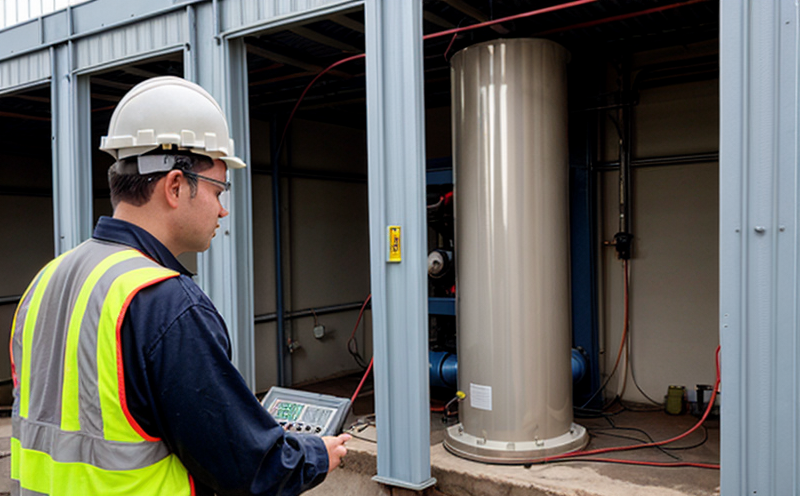Vibration monitoring inspection
In the construction and building sector, vibration monitoring inspection is a critical component of ensuring structural integrity and safety. This process involves the systematic measurement and analysis of vibrations within structures to identify potential issues that could compromise durability or performance over time.
Understanding the principles behind this test is essential for those involved in quality management, compliance assurance, R&D, and procurement. Vibration monitoring allows for early detection of structural anomalies, which can prevent costly repairs and ensure the longevity of buildings. This method employs advanced instrumentation to gather precise data on vibration levels, providing insights into the condition of various components.
The importance of this inspection cannot be overstated in ensuring compliance with international standards such as ISO 2372 and ASTM E1680. These guidelines provide benchmarks for acceptable vibration levels within structures, which are crucial for maintaining safety standards and preventing accidents.
- Identifies potential structural weaknesses early
- Promotes adherence to international standards
- Ensures compliance with regulatory requirements
- Enhances overall building safety and longevity
| Application Example | Vibration Levels (Hz) | Expected Outcome |
|---|---|---|
| Monitoring a high-rise building during construction | 10–25 Hz | Identification of potential structural fatigue |
| Evaluating the impact of machinery on nearby buildings | 30–40 Hz | Determination of compliance with noise regulations |
The process involves detailed specimen preparation, where sensors are strategically placed around the structure to capture accurate data. The instrumentation used in this inspection includes accelerometers and other vibration meters that can measure displacement, velocity, and acceleration.
After collecting the necessary data, comprehensive analysis is conducted using specialized software. This step ensures that any deviations from acceptable levels are highlighted promptly. Reporting follows strict guidelines, ensuring clarity and accuracy for all stakeholders involved.
Why Choose This Test
- Precise Measurement: Advanced instrumentation allows for accurate measurement of vibration levels.
- Early Detection: Identifies potential issues before they escalate into serious problems.
- Compliance Assurance: Ensures adherence to international standards like ISO 2372 and ASTM E1680.
- Safety Enhancement: Protects occupants by ensuring structural integrity.
Vibration monitoring is a reliable method for assessing the health of buildings, particularly in sectors where vibration could have significant impacts on structures. This test is especially valuable in high-rise buildings, bridges, and other critical infrastructure projects.
The reliability and precision of this inspection make it an essential tool for quality assurance professionals looking to maintain safety standards. By investing in regular vibration monitoring inspections, organizations can save substantial costs associated with unexpected failures or accidents.
International Acceptance and Recognition
Vibration monitoring is widely recognized and accepted across the globe as a critical tool for ensuring structural integrity. The International Organization for Standardization (ISO) has established guidelines such as ISO 2372, which provide detailed specifications on how to perform vibration measurements accurately.
Similarly, organizations like ASTM have developed standards such as E1680 that set benchmarks for acceptable vibration levels within various structures. These international standards ensure consistency and reliability in the field of structural health monitoring.
The acceptance of this test is not limited to academia or research; it has been widely adopted by construction firms, engineering companies, and government agencies around the world. This global recognition underscores its importance in maintaining safety and quality in building projects.
Use Cases and Application Examples
- High-Rise Buildings: Monitoring during construction to detect early signs of structural fatigue.
- Critical Infrastructure: Evaluating the impact of machinery on nearby structures for compliance with noise regulations.
- Bridge Structures: Assessing the effects of environmental factors like wind and traffic on bridge stability.
- New Construction Sites: Identifying potential issues from excavation or other construction activities before they lead to significant damage.
| Application Example | Vibration Levels (Hz) | Expected Outcome |
|---|---|---|
| Evaluating the impact of machinery on a nearby high-rise building | 35–40 Hz | Determination of compliance with noise regulations and potential structural impacts |
| Monitoring a bridge during heavy traffic periods | 20–30 Hz | Assessment of the bridge's resilience to vibrations caused by vehicles |
Vibration monitoring is essential for ensuring that buildings and structures meet strict safety standards. By leveraging this technology, construction professionals can enhance project quality and safety, thereby reducing risks associated with structural failures.





